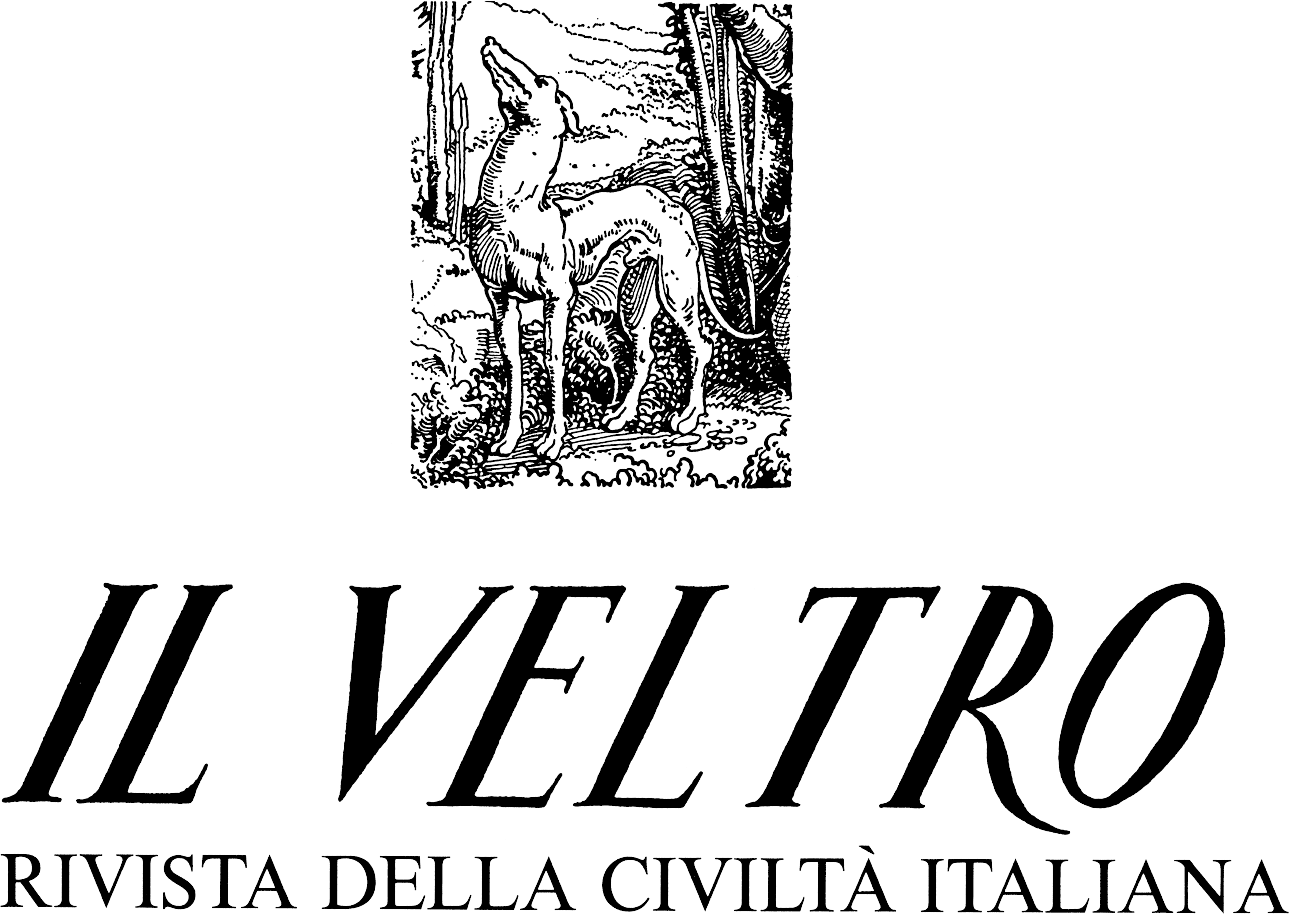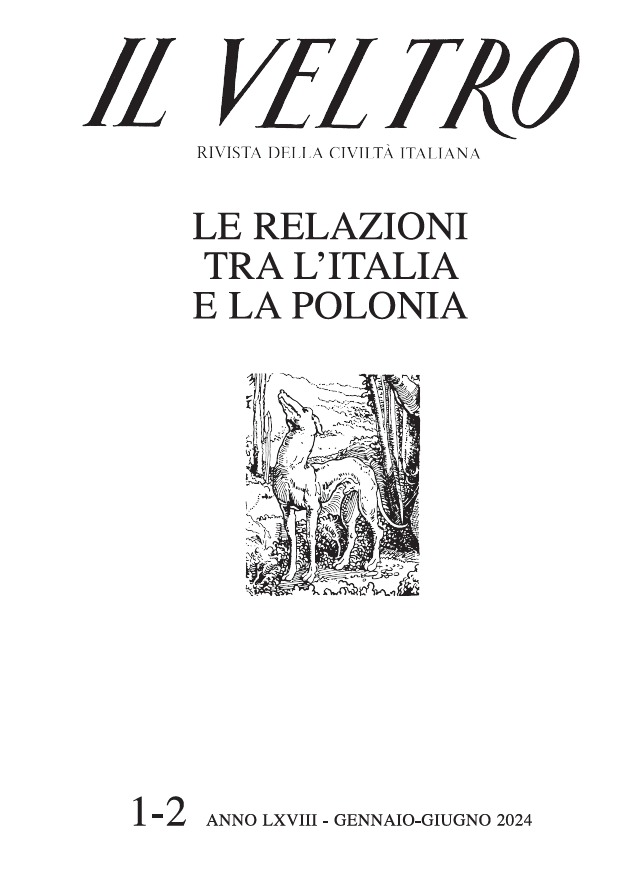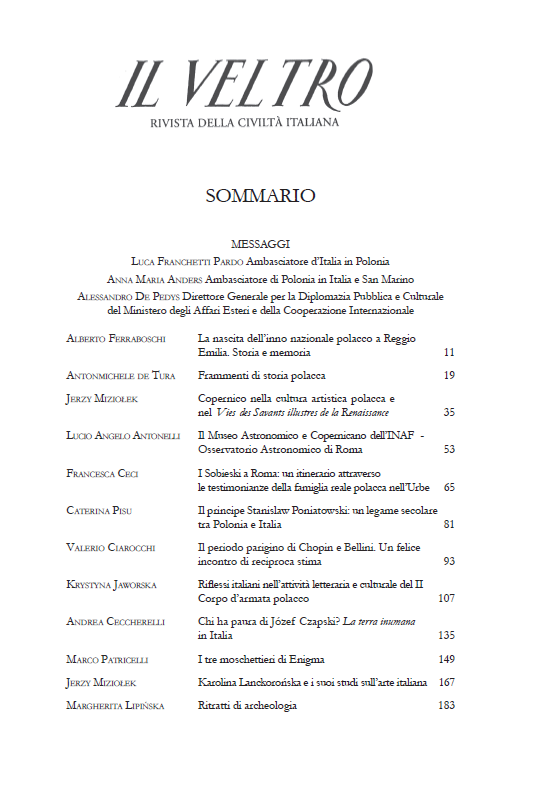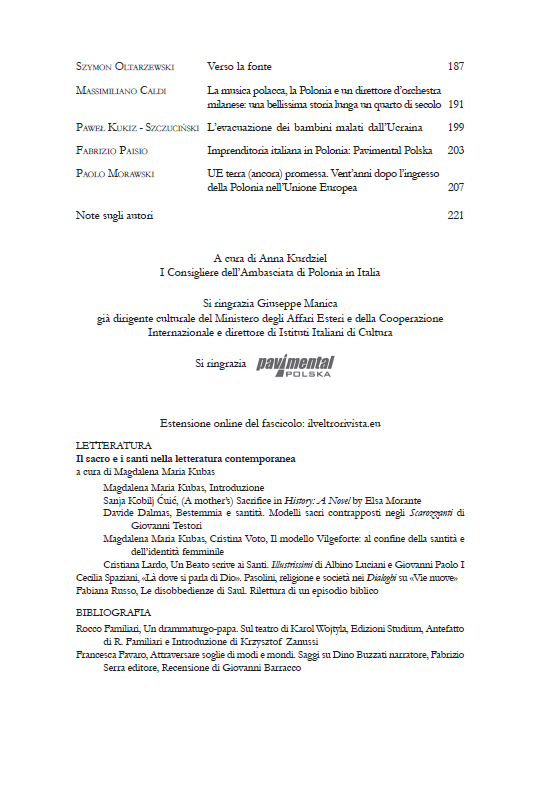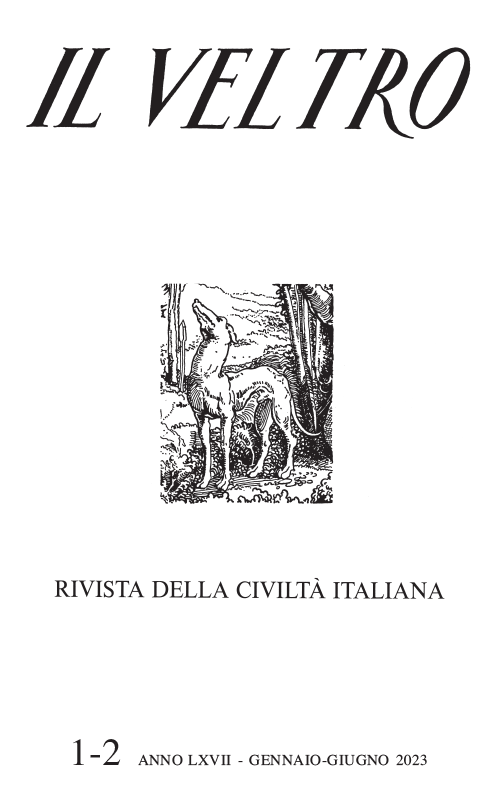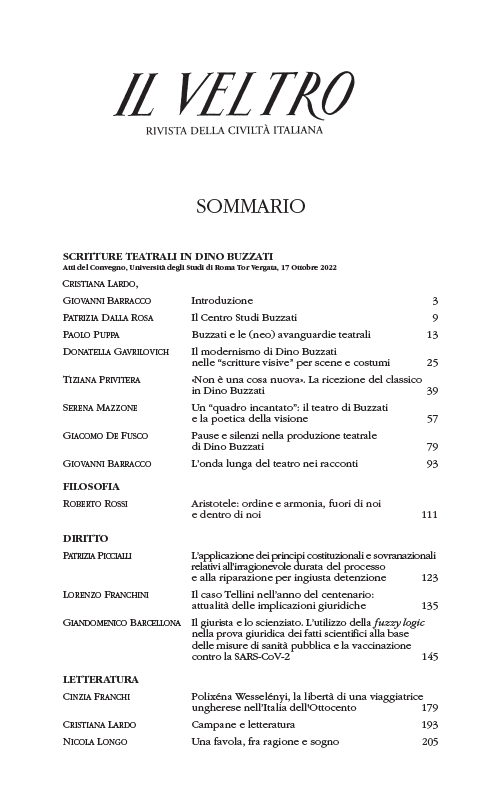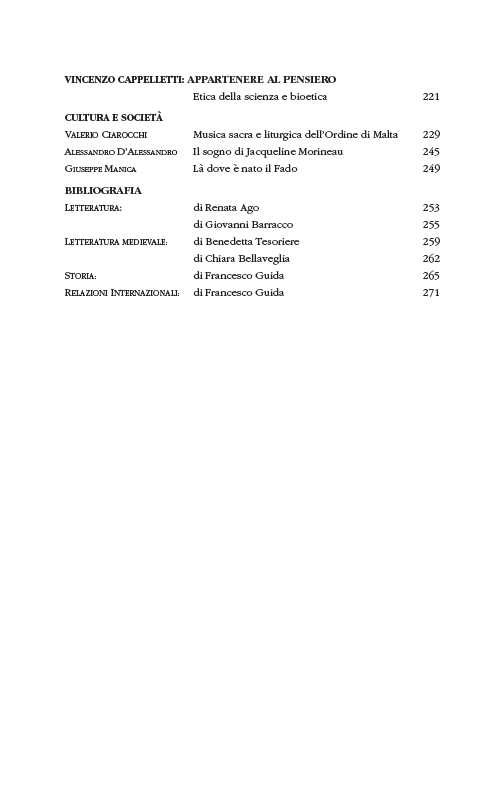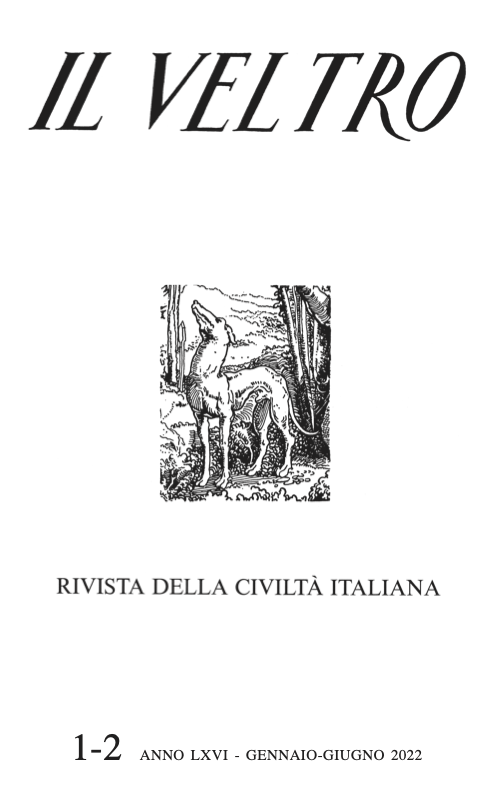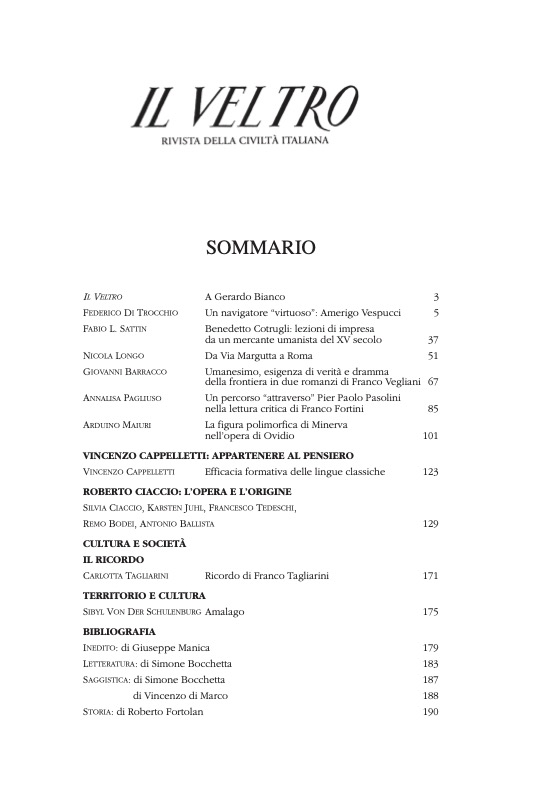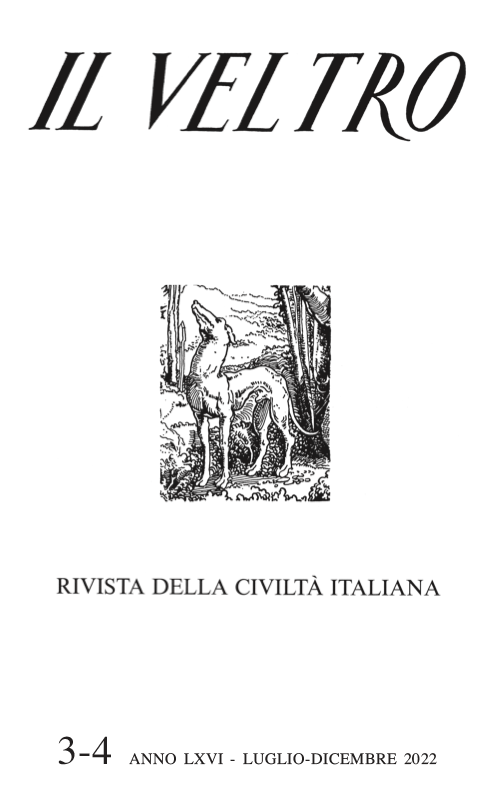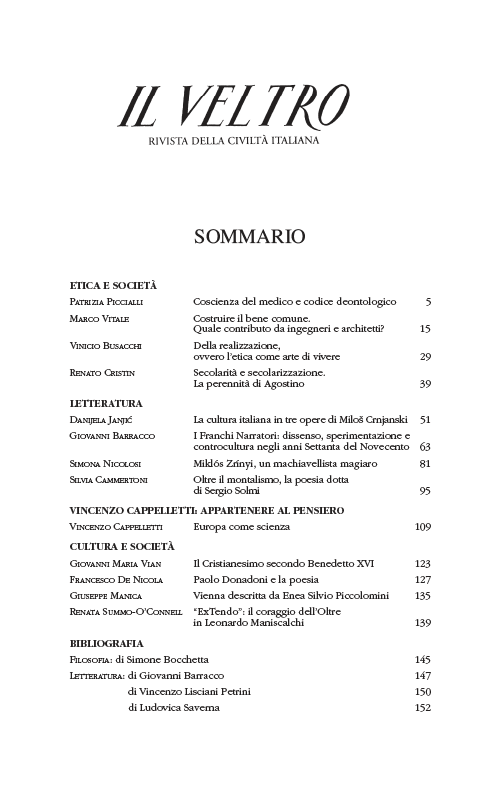2024
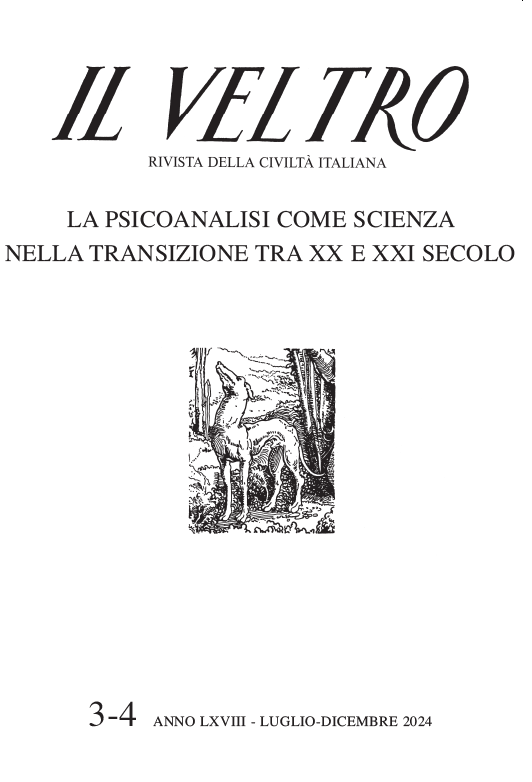
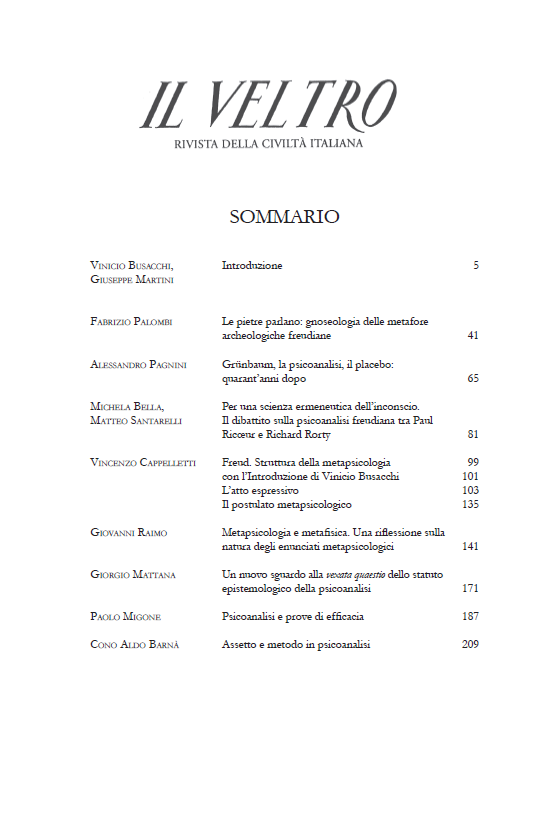
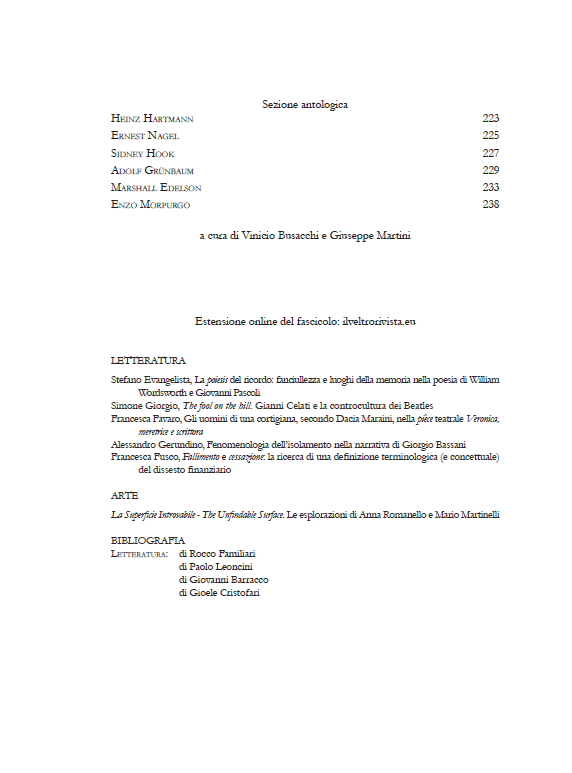
In questo numero:
Il contributo presenta un inventario ragionato delle analogie tra psicoanalisi e
archeologia contenute nelle opere di Freud e in alcuni suoi epistolari. L’intento è quello
di mostrare come la psicoanalisi possa trovare nell’archeologia un modello gnoseologico
per fondare la propria pratica.
This paper presents a reasoned survey of the analogies between psychoanalysis and
archaeology within Freud’s works and in some of his epistolaries. The aim is to show
how psychoanalysis can find in archaeology a gnoseological model to ground its practice.
Sono trascorsi quarant’anni dalla critica filosofica di Grünbaum alla psicoanalisi
freudiana. Da allora la psicoanalisi ha modificato molte delle sue teorie (fino al
punto di rinunciare alla metapsicologia), la scienza è progredita soprattutto per quello
che riguarda il campo biomedico e psicologico (medicina e psicobiologia neodarwiniane)
e la filosofia della scienza, a sua volta, non si occupa più di fondamenti assoluti
della conoscenza e di “Metodo” scientifico, declinando al singolare anche le esigenze
di validazione e in generale i requisiti epistemici delle diverse teorie. Della sfida di
Grünbaum resta comunque urgente l’istanza posta dalle più recenti prospettive neurofisiologiche
e cliniche sul placebo e resta interessante e dibattuto l’aspetto metodologico
che riguarda la parte sperimentale della sua validazione.
Forty years have passed since Grünbaum’s philosophical critique of Freud’s psychoanalysis.
Since then, psychoanalysis has modified many of its theories (to the point
of renouncing metapsychology), science has progressed above all in the biomedical
and psychological fields (neo-Darwinian medicine and psychobiology), and philosophy
of science, in turn, no longer deals with absolute foundations of knowledge and the
scientific ‘Method’, also declining to the singular the validation requirements of the
various theories. Of Grünbaum’s challenge, however, the demand posed by the most
recent neurophysiological and clinical perspectives on the placebo remains urgent, and
the methodological aspect concerning the experimental part of its validation remains
interesting and debated.
La posizione ambigua di Freud sul ruolo del linguaggio nei processi inconsci ha
portato a una netta divisione nella ricezione filosofica delle sue idee. Da un lato, ci si
concentra su concetti come impulsi, spiegazioni e pulsioni pre-sociali, mentre dall’altro
si enfatizzano gli atti linguistici, l’interpretazione, le ragioni e i processi sociali. Le implicazioni
per lo status scientifico della psicoanalisi sono chiare. Alcuni ritengono che la
psicoanalisi voglia affermarsi come scienza esatta e naturale. Altri classificano la psicoanalisi
come una scienza interpretativa. L’obiettivo principale di questo lavoro è duplice:
in primo luogo, confrontare le interpretazioni del pensiero di Freud da parte di due figure
di spicco della filosofia del XX secolo con retroterra culturali in parte diversi, Ricoeur e
Rorty. In secondo luogo, promuovere un dialogo tra una lettura ermeneutica e una (neo)
pragmatista della psicoanalisi. La nostra ipotesi è che una prospettiva pragmatista possa
aiutare a integrare e ricostruire le intuizioni più perspicaci e produttive dell’interpretazione
ermeneutica della psicoanalisi. In ultima analisi, ciò implica riconsiderare, da un
punto di vista ermeneutico-(neo)pragmatista, la questione dello status scientifico della
psicoanalisi al di là degli stretti confini stabiliti dal modello natura versus cultura.
Freud’s ambiguous stance on the role of language in unconscious processes has
led to a clear divide in the philosophical reception of his ideas. On one side, there
is a focus on concepts like impulses, explanation, and pre-social drives, while on the
other, linguistic acts, interpretation, reasons, and social processes are emphasized.
The implications for the scientific status of psychoanalysis are clear. Some believe
82
that psychoanalysis aims to establish itself as an exact and natural science. Others
classify psychoanalysis as an interpretive science. The primary aim of this work is
twofold: first, to compare the interpretations of Freud’s thought by two leading figures
in 20th-century philosophy with partly different cultural backgrounds, Ricoeur and
Rorty. Secondly, to foster a dialogue between a hermeneutic and a (neo)pragmatist
reading of psychoanalysis. Our hypothesis is that a pragmatist perspective can help
integrate and reconstruct the most insightful and productive insights from the hermeneutic
interpretation of psychoanalysis. Ultimately, this involves reconsidering, from
a hermeneutic-(neo)pragmatist standpoint, the issue of the scientific status of psychoanalysis
beyond the limited boundaries set by the nature versus culture model.
Con l’Introduzione di Vinicio Busacchi
Quando ci chiediamo se la psicoanalisi sia una scienza, dovremmo partire dalla constatazione che, nella comunità dei filosofi e degli scienziati, non vi è accordo né sulla definizione del termine “scienza”, né sulla formulazione di un criterio di demarcazione. A tal proposito, nella letteratura critica sull’argomento, si parla in genere di “nucleo metafisico” della scienza. Ragionevolmente
dovremmo allora porci due ordini di questioni: da una parte chiederci qual sia
il modo migliore per presentare un modello psicoanalitico, al fine di
confrontarlo con gli altri, e quali siano i criteri di scelta che è ragionevole
adottare; dall’altra, dovremmo riflettere su che tipo di enunciati sono gli
assiomi metapsicologici: sono enunciati descrittivi, dotati cioè di un valore
di verità e confrontabili quindi con qualcosa che possiamo chiamare “mondo”,
“realtà”, “fatti”, “osservazioni cliniche” ecc., o sono invece enunciati privi
di un valore di verità, come lo sono gli enunciati metafisici o ancora quelli
paradigmatici?
When we ask
ourselves whether psychoanalysis is a science, we should start from the
observation that, in the community of philosophers and scientists, there is no
agreement either on the definition of the term “science” or on the formulation
of a demarcation criterion. In this regard, in the critical literature on the
topic, we generally speak of the “metaphysical core” of science. We should then
reasonably ask ourselves two sets of questions: on the one hand, ask ourselves
what is the best way to present a psychoanalytic model, in order to compare it
with others, and what are the selection criteria that are reasonable to adopt; on
the other hand, we should reflect on what type of statements the
metapsychological axioms are: are they descriptive statements, that is, endowed
with a truth value and therefore comparable with something that we can call
“world”, “reality”, “facts”, “clinical observations ” etc., or are they instead
sentences devoid of a truth value, as are metaphysical sentences or even
paradigmatic ones?
Il tema della scientificità difficilmente può essere eluso, poiché riguarda direttamente l’identità della psicoanalisi. Freud ha costantemente oscillato fra un criterio di scientificità metodologico e un criterio ontologicamente riduzionista. Il secondo subordina la psicoanalisi alle neuroscienze, mentre il primo ne salvaguarda l’autonomia epistemologica. Le domande dell’epistemologia alla psicoanalisi possono rappresentare un utile stimolo al rafforzamento dello statuto scientifico della disciplina. Ciò può tradursi in una migliore integrazione fra i modelli, che faccia del pluralismo teorico della psicoanalisi un fattore di forza e ricchezza e non di debolezza e frammentazione. La griglia concettuale dell’epistemologia contemporanea è particolarmente adatta a favorire tale evoluzione, nel rispetto della complessità dell’oggetto della psicoanalisi e senza introdurre nel suo metodo parametri estranei.
The issue of scientificity can hardly be evaded, as it directly affects the identity of psychoanalysis. Freud constantly oscillated between a methodological and an ontologically reductionist criterion of scientificity. The latter subordinates psychoanalysis to neuroscience, while the former salvages its epistemological autonomy. Epistemology’s questions to psychoanalysis can be useful stimuli to the strengthening of the scientific status of the discipline. This can result in a better integration among models, making the theoretical pluralism of psychoanalysis a factor of strenght and richness and not of weakness and fragmentation. The conceptual grid of contamporary epistemology is particularly suited to foster such an evolution, while respecting the complexity of the object of psychoanalysis and without introducing extraneous parameters into its method.
Vengono prese in rassegna e discusse alcune tematiche riguardanti il problema delle prove di efficacia della psicoanalisi. Innanzitutto viene esaminata, anche con alcune considerazioni filosofiche, la differenza tra ricerca empirica e ricerca clinica, che sono molto diverse: la prima viene fatta nel laboratorio sperimentale, mentre la seconda è condotta dallo psicoanalista nel suo lavoro con i pazienti. Viene poi discusso se nella psicoanalisi, e più in generale nella psicoterapia, sia possibile la replicabilità, che è una caratteristica centrale del metodo scientifico. Viene quindi tracciato un panorama della storia del movimento di ricerca in psicoterapia, in cui vi è stata una prima fase dedicata prevalentemente al risultato della terapia e una seconda fase dedicata al processo. Infine vengono riassunte alcune recenti ricerche sull’efficacia della psicoanalisi, dove emerge sempre di più che la psicoanalisi e la terapia psicodinamica non sono inferiori, ma a volte anche superiori, alla terapia cognitivo-comportamentale.
Some issues concerning the problem of the efficacy of psychoanalysis are reviewed and discussed. First of all, the difference between empirical research and clinical research, which are very different, is examined, including some philosophical considerations: the former is conducted in the experimental laboratory, while the latter is carried out by the psychoanalysts in their daily work with patients. It is then discussed whether replicability, a central feature of scientific method, is possible in psychoanalysis and more generally in psychotherapy. An overview of the history of the psychotherapy research movement is then provided, in which there was an initial phase predominantly focused on outcome research and a second phase dedicated to process research. Finally, some recent research on the efficacy of psychoanalysis is summarized, increasingly showing that psychoanalysis and psychodynamic therapy are not inferior to, and sometimes even superior to, cognitive-behavioral therapy.
L’autore espone alcune riflessioni all’interno di una verifica e di una revisione delle idee e degli scritti prodotti in tanti anni di pratica clinica. Si tratta di riflessioni e formulazioni che si sono giovate del confronto con la pratica e con gli avanzamenti concettuali della psicoanalisi, delle discipline affini di riferimento e, soprattutto, delle ricerche interdisciplinari correlate. A partire dalla questione epistemologica, tanto pregnante quanto irrisolta, dichiara il coinvolgimento della psicoanalisi in un dibattito che riguarda tutte le scienze umane. Afferma quindi la necessità di chiarire sempre meglio la collocazione epistemologica della psicoanalisi in termini accurati. La stessa epistemologia essendo in un divenire critico costante, è necessario farlo in riferimento alle risultanze aggiornate della riflessione relativa. Alle risultanze dell’epistemologia moderna ma anche agli ultimi studi sul cervello e sulla mente, nel timore che, presi dalla fede sull’estensione dello psichico e sulla sua ineffabilità si verifichi l’errore di non fare coincidere la mente e l’estensione dello psichico, con il nostro cervello: con il funzionamento cioè dell’hardware neurologico che produce la mente. La risoluzione proposta è quella di precisare che la psicoanalisi è essenzialmente un metodo, un protocollo complesso di osservazione e di intervento che risponde ancora alla primaria definizione che Freud ne diede nel ‘22: «1) procedimento per l’indagine dei processi psichici cui altrimenti sarebbe pressoché impossibile accedere; 2) metodo terapeutico (basato su tale indagine) dei disturbi nevrotici; 3) una serie di conoscenze psicologiche acquisite per questa via che gradualmente si assommano e convergono in una nuova disciplina scientifica» (Freud, 1922, p. 439). Un metodo, dunque, che si riferisce ad una complessa teoria in divenire, con un proprio assetto operativo che rintraccia fattori terapeutici, specifici e riproducibili, i quali attengono ad un risultato atteso nell’ambito specifico della mentalizzazione, e che esita in una comprensione adattiva del soggetto del proprio “essere nel mondo”. La ricchezza incrementale dei modelli, proposti nel tempo, rivelerebbe inoltre, certamente la creatività della ricerca psicoanalitica, l’estensione dello psichico nella storia, nel gruppo e nel sociale, ma anche la difficoltà della formulazione dell’aspetto “oggettivo”, scientificamente evidente, a fondazione di tale psichico.
The author sets forth some reflections within a review and revision of ideas and writings produced over many years of clinical practice. These are reflections and formulations that have benefited from comparison with practice and conceptual advances in psychoanalysis, related disciplines of reference and, above all, related interdisciplinary research. Beginning with the epistemological question, which is as pregnant as it is unresolved, he declares the involvement of psychoanalysis in a debate that affects all the human sciences. He then affirms the need to increasingly clarify the epistemological place of psychoanalysis in accurate terms. Epistemology itself being in a constant critical becoming, it is necessary to do so with reference to the updated findings of related reflection. To the findings of modern epistemology but also to the latest studies on the brain and mind, lest, caught up in the faith about the extension of the psychic and its ineffability we make the mistake of not making the mind and the extension of the psychic, coincide with our brain: that is, with the functioning of the neurological hardware that produces the mind. The proposed resolution is to make it clear that psychoanalysis is essentially a method, a complex protocol of observation and intervention that still meets Freud’s primary definition of it in ‘22: “(1) a procedure for the investigation of psychic processes which it would otherwise be almost impossible to access; (2) a therapeutic method (based on such an investigation) of neurotic disorders; (3) a series of psychological knowledge acquired by this route which gradually assimilates and converges into a new scientific discipline” (Freud, 1922, p. 439). A method, then, that refers to a complex theory in the making, with its own operational set-up that traces therapeutic factors, specific and reproducible, which pertain to an expected outcome in the specific area of mentalization, and which results in the subject’s adaptive understanding of his or her own “being in the world.” The incremental wealth of models, proposed over time, would also reveal, certainly the creativity of psychoanalytic research, the extension of the psychic into history, the group and the social, but also the difficulty of the formulation of the scientifically evident “objective” aspect at the foundation of such psychic.
Heinz Hartmann
Ernest Nagel
Sidney Hook
Adolf Grünbaum
Marshall Edelson
Enzo Morpurgo
2023
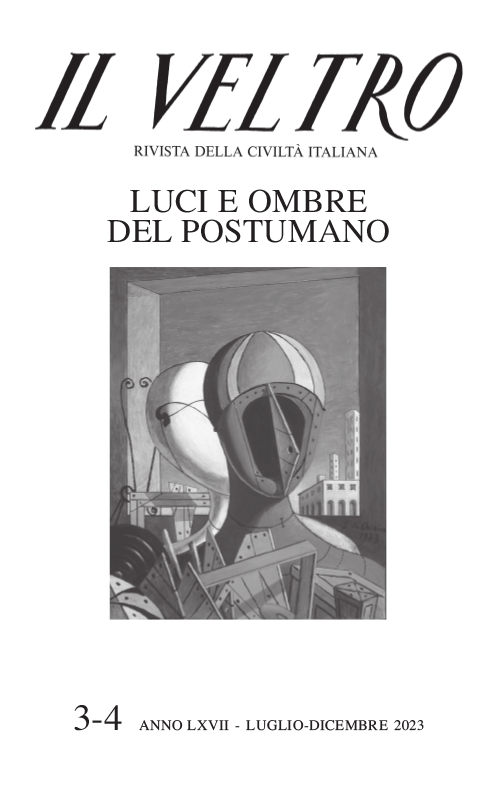
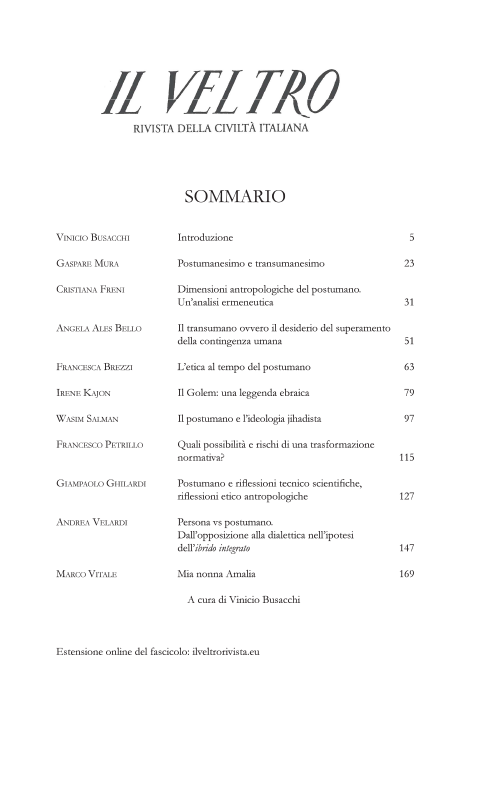
- NUMERO 3-4 ANNO LXVII
LUGLIO-DICEMBRE 2023
In questo numero:
Questo contributo offre una sintesi breve delle principali teorie del postumanesimo e del transumanesimo, un ripercorrimento riflessivo e critico alla luce della tradizione classica, filosofica e religiosa. L’autore avanza la tesi che la dignità dell’uomo come persona dipende dalla sua dimensione interiore, che è una dimensione spirituale e filosofica, culturale ed etica. È del tutto indipendente dal discorso delle tecnologie e delle sue promesse.
This contribution offers a brief summary of the main theories of posthumanism and transhumanism. It is a rejleaive and criticai review in the light of the classica, philosophical and religious tradition. The author sustains that the digniry of the human being as a person depends on his internal dimension, which is a spiritual, philosophical, cultural and ethical dimension. It is completejy independent from the discourse concerning technologies and its promises.
L’articolo affronta la questione del postumano a partire da una prospettiva storica, antropologica ed ermeneutica. Si evidenziano le specificità del dibattito attuale, le emergenze ontologiche del postumano, il ruolo heideggeriano della tecnica, la necessità di tornare all’asse costitutivo dell’essere umano ripercorso alla luce della fenomenologia, secondo un paradigma integrale della persona. Emergono le criticità nel confronto ermeneutico, ma anche l’auspicio a direzionare il progresso e la ricerca postumana verso un futuro non disumano.
This article addresses the question ef posthumanism starting from a historical, anthropological and hermeneutical perspeaive. The specificities of the current debate around the ontological emergencies ef the posthuman are highlighted· the Heideggerian role ef technology, the necessity to reaffirm the constitutive axis ef the human being, retraced in the light ef phenomenology, according to an integrai paradigm ef the person. Criticai issues emerge in the hermeneutic comparison, but also the hope ef direaing both, progress and posthuman research towards, a non-inhuman future.
Dopo aver descritto i tratti caratteristici del transumanesimo, che si è configurato negli ultimi trent’anni prevalentemente in ambiente anglosassone, si prende in considerazione il sottotitolo, cioè, il desiderio di superamento della contingenza umana e si esaminano le esperienze vissute che sono alla base di questo desiderio. Si nota, inoltre, che l’estensione senza fine della vita proposta dal transumanesimo, richiede l’utilizzo della fantasia, cioè, la creazione di un mondo che supera il piano esperienziale. Si tratta dell’assolutizzazione dell’umano dal punto di vista spazio-temporale che sigiustijica con la presenza in noi del divino, anche se è respinta. Le proposte teoriche del transumanesimo si presentano, pertanto, con una venatura cripto-religiosa.
After the description of the main jèatures of the transumanismus, which develops itself in the fast thirry years in the English-speaking milieu, the subtitle is examined regarding the meaning of the Italian words “desiderio”: wish. What the human being really wishes is linked up with his/ her fast destination. One can note that in the ”new”post-humanistic description of human !ife without an end, requires the use of fantasy, that is the creation of a new world, far from the world in which we live. In such a way the human being is considered as something absolute, who will live far ever in our space and time and this “absolute” comes from the presence of the Divine in us, even if it is not accepted. Therefore, in the transhumanistic theories there is the hidden-presence of a re!igious attitude.
Sorta come risultato del tentativo contemporaneo di ridefinizione della condizione umana, la riflessione postumana rappresenta un dibattito in corso, pensieri in cammino che si sviluppano in diversi movimenti e prospettive. Alla domanda antropologica: chi sono io? La risposta da condividere anche con il pensiero postumano è la visione dinamica dell’essere umano: l’identità, secondo gli ultimi studi (filosofici e scientifici) non è qualcosa di dato, ma è sempre il risultato di un ‘azione, in virtù della quale non si traccia una demarcazione definitiva, tra identico e diverso, tra interno ed esterno, tra proprio ed estraneo, tra amico e nemico. Ne deriva il rifiuto di ogni essenzialismo, e la disponibilità al nomadismo (senza eccedere), come ormai sostenuto da moltifilosofi e filosofe (Gehelen, Ricoeur, Braidotti etc.).
Having arisen as a result ef the contemporary attempt to redefine the human condition, posthuman rejlection represents an ongoing debate, thoughts on the move that develop into different movements and perspeaives. To the anthropological question: who am I? The answer to be shared also with posthuman thought is the 4Ynamic vision ef the human being: identity, according to the latest studies (philosophical as well as scientiftc) is not something given, but is alwqys the result of an action, in virtue of which no definitive demarcation is drawn between identical and different, between internal and external between one’s own and a stranger, between friend and enemy. The result is the rejection of any essentialism, and the availability far nomadism (without exceeding), as now supported by many philosophers (Gehelen, Ricoeur, Braidotti etc.).
Il contributo presenta la riflessione compiuta dall’ebraismo su una società in cui i mezzi efferti dalla tecnologia sembrano condurre a una nuova idea dell’uomo, concentrandosi sulla figura del Golem. Si prende in esame in esso la genesi di tale figura in età talmudica e le sue intepretazioni successive, fino a giungere all’età contemporanea.
This paper considers the Jewish reflection on a society in which the means offered by technology seem to lead to a new idea of man. It focuses on the figure of the Golem and examines the genesis of this figure in the Talmudic age and its fallowing interpretations, up to the contemporary age.
Li tecnologia ha trasformato l’umanità e il mondo contemporaneo. Qual è il suo impatto sull’islam? La fede islamica è cambiata nel contesto postumano? Il presente articolo intende rispondere a queste domande, concentrandosi sulla storia più recente dell’islam e sulle nuove ideologie islamiche apparse negli ultimi decenni. L’Afghanistan è la prima tappa dello studio, soprattutto per quanto riguarda l’epoca dei Talebani e la loro strana e disumana farma di islam. In secondo luogo, la Siria – che per secoli era stata il cuore dell’impero musulmano e un centro di produzione filosofica, artistica e scientifica – si è trasformata con l’arrivo dell’ISIS nel centro internazionale della Jihad, in cui bambini, donne e uomini sono stati uccisi senza pietà in nome di Dio. Infine, anche le carceri europee sono diventate celle per l’indottrinamento jihadista. Li ricerca attuale offre un panorama della nuova ideologia jihadista rispetto al fenomeno del postumano.
Technology has tran.iformed humankind and the contemporary world. What is its impaa on islam? Has islamic faith changed in the post-human context? The present article aims to answer these questions, facusing on the most recent history ef islam and the new islamic ideologies that have appeared in the last few decades. Afghanistan is the ftrst step of the study, especially in the Taliban era and their strange and inhuman farm ef islam. Secondly, Syria – which had been the heart ef the Muslim empire far centuries and a centre of philosophical, artistic and scientific production – was transformed with the arrival of ISIS into the international centre of ]ihad, in which children, women and men were killed without merry in the name of God. Finally, European prisons also became cells far jihadist indoctrination. The aaual research offers a panorama of the new jihadist ideology with respea to the post-human phenomenon.
Nella difficoltà di pensare alla legge come regola possibile dei rapporti postumani, il normativo, attraverso il metodo ermeneutico, può trovare nella direttiva giuridica un possibile percorso-guida.
In the difficulty of thinking on Law as a possible rule of post-human relationships, the normative can find a possible guiding path in legai directive through the hermeneutic method.
La saldatura tra Postumanesimo e pensiero tecnico scientifico non è semplicemente un fatto osservabile e attestato, ma è anzitutto un tratto essenziale e costitutivo di questo movimento. In questo lavoro si analizzeranno le radici storiche e teoretiche di questa fusione insieme alle ripercussioni antropologiche che ne derivano.
The connection between Posthumanism and Techno-Scientiftc thought is more than an observable fact, its rather a specific feature of Posthumanism itself, since it relies upon the very nature of this philosophy. In the present work this connection will be investigated in both its historical roots and theoretical premises together with the anthropological consequences entailed
Il presente contributo effronta la possibile integrazione tra teoria della persona e postumanesi mo. Attraverso la teoria di Bernard S tiegler sul nesso originario tra umanità, tecnica e temporalità e sull’intreccio tra l’oblio di Epimeteo che lascia l’uomo nudo e la hybris di Prometeo che gli procura il fuoco, si elabora la dipendenza originaria dalla tecnica che addirittura precede l’uomo attraverso l’accumulazione di esteriorizzazioni in linguaggi e documenti. Questo sfondo spiega l’ambivalenza della tecnica come pharmakon che può essere curativo, ma anche diventare pervasivo e tossico generando regressione e mancata interiorizzazione dei contenuti che la tecnica esteriorizza. Questa prospettiva conduce ad una rivalutazione degli aspetti positivi del postumanesimo non come creazione di una nuova specie bionica, ma come potenziamento iper-umanistico dell’essere umano. Ne consegue l’integrazione con il personalismo all’interno di una teoria dell’ibrido integrato dove la virtuosità dell’ibridazione transumana si misura attraverso la funzionalità della polarità della tecnica alla polarità dell’umano nel processo di potenziamento e di trascendimento.
The aim ef the paper is to address the issue of a possible integration between theory ef person and post-humanism. Trough the theory ef Bernard Stiegler about the origina! connection among human, technique and temporali!) and about the interplqy between the oblivion ef Epimetheus and the hybris of Prometheus, we outline the origina! defect ef human being and his dependence on the technique that precedes him with an amount ef externalizations like languages and documentali!). This background explains the ambivalence ef the technique as pharmakon that can recovery or at the same time be poison generating regression and missed interiorizations ef the externalizations. That conclusion leads to an evaluation ef the positive aspects ef post-humanism not referring the creation ef a new bionic species, but the hyper-humanistic enhancement ef human being. Thus the reconciliation between personalism and post-humanism is available within a theory of the integrated hybrid in which is valued the work of the polarity of technique toward the polarity of human in order to achieve the hyper-human transcendence.

